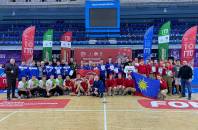|
Региональный журнал для деловых кругов Дальнего Востока
|
|
||||||||||||||||||||||
|
Воскресенье| 02 Ноября, 15:55 |
|
|
Тема номера
|
|||||||||||||||||||||

 Олег Кожемяко осуществил новогодние желания маленьких приморцев
В преддверии новогодних праздников заветные желания маленьких приморцев начинают сбываться. Так, Губернатор Приморского края Олег Кожемяко передал подарки от Деда Мороза двум маленьким приморцам: шестилетнему Мирону Глушаку из Тернейского муниципального округа и четырёхлетней Ольге Алимпиевой из Арсеньева.
Олег Кожемяко осуществил новогодние желания маленьких приморцев
В преддверии новогодних праздников заветные желания маленьких приморцев начинают сбываться. Так, Губернатор Приморского края Олег Кожемяко передал подарки от Деда Мороза двум маленьким приморцам: шестилетнему Мирону Глушаку из Тернейского муниципального округа и четырёхлетней Ольге Алимпиевой из Арсеньева.
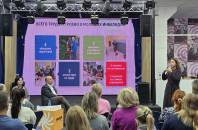 Родители ребят с ОВЗ обсудили вопросы образования и трудоустройства с представителями власти Приморья
Третья встреча клуба "На равных", призванного помогать гражданам решить непростые жизненные ситуации, состоялась в Приморье. В этот день участниками клуба стали родители детей с инвалидностью и ограниченными возможностями здоровья. Они обсудили с представителями власти вопросы образования и трудоустройства таких ребят.
Родители ребят с ОВЗ обсудили вопросы образования и трудоустройства с представителями власти Приморья
Третья встреча клуба "На равных", призванного помогать гражданам решить непростые жизненные ситуации, состоялась в Приморье. В этот день участниками клуба стали родители детей с инвалидностью и ограниченными возможностями здоровья. Они обсудили с представителями власти вопросы образования и трудоустройства таких ребят.
 Социальные предприниматели Приморья могут найти кадры и получить рекламу на радио при господдержке
Открыт прием заявок на две актуальные для социальных предпринимателей меры поддержки: "Размещение двух вакансий на HeadHunter" и "Размещение рекламы на радиостанции". Такой формат господдержки поможет социальному бизнесу Приморья продвигать свои услуги в осенний период и найти профессиональные кадры для расширения штата.
Социальные предприниматели Приморья могут найти кадры и получить рекламу на радио при господдержке
Открыт прием заявок на две актуальные для социальных предпринимателей меры поддержки: "Размещение двух вакансий на HeadHunter" и "Размещение рекламы на радиостанции". Такой формат господдержки поможет социальному бизнесу Приморья продвигать свои услуги в осенний период и найти профессиональные кадры для расширения штата.
 24 протокола составили на нарушителей противопожарного режима в приморских лесах
Лесничие и инспекторы в Приморье составили 24 протокола в отношении нарушителей особого противопожарного режима на землях лесного фонда. ОПР действует в большинстве муниципалитетов и подразумевает крупные штрафы за пренебрежение правилами пожарной безопасности.
24 протокола составили на нарушителей противопожарного режима в приморских лесах
Лесничие и инспекторы в Приморье составили 24 протокола в отношении нарушителей особого противопожарного режима на землях лесного фонда. ОПР действует в большинстве муниципалитетов и подразумевает крупные штрафы за пренебрежение правилами пожарной безопасности.
MIG Investment Group: We need comprehensive investment
Major projects have appeared recently that are unique not only in terms of location and climate, but also in terms of the business conditions investors have to contend with, finding solutions to challenges that are often very unconventional. It is these solutions that are shaping the face of the region’s new economy. Participation in these processes is appealing, as it offers a broad range of opportunities for implementing business ideas, says Stanislav Ermolenko, president of MIG Investment Group.
After completing the initial stage of implementing the largest cattle farming project in the RFE, setting new production standards in regional agriculture and gaining experience in marketing Primorsky produce in neighboring countries, including South Korea, Ermolenko now has an optimistic view of cooperation prospects with business partners on the Pacific Rim:
“Our value is in the great potential of our land. Russia is home to over 140 million people, and in the RFE we can offer our Asian partners a beachhead close to home for entering a new market and setting up production of various consumer goods and food to sell to the people of both countries. This is very important, as it is quite convenient doing business just two hours from home by plane. Planes fly anywhere these days, but a Japanese or Korean company with production facilities in Russia would find it easier to control, operate and manage these facilities if they are in the RFE. Geographic proximity is important because it makes it possible to manage a business more efficiently.”
However, this is not the only thing that makes our region appealing for agricultural businesses. When starting construction of a large pig farm in Primorsky Region’s Spassk District, MIG Investment Group took steps to ensure the environmental safety of the facilities at every stage of the project, “and this is a global problem,” says Ermolenko. “Smaller countries set caps on cattle numbers even when farms are using state-of-the-art technologies for raising cattle. Exceeding these caps can result in severe problems for the environment. At the same time, the availability of so-called clean areas is a clear advantage that helps improve the quality of the end product.
“Our pig farming program is geared to supply pork to the RFE first, followed eventually by exports to other countries - South Korea, for example. This may sound ambitious, but it is within our reach. However, to start the exports we would need to make a tremendous organizational effort on top of our focus on operations to persuade the Russian government and the governments of prospective destination countries. We are currently in talks about this with our foreign partners, and not just our business partners. However, this is probably a job for the government - the Russian Ministry of Agriculture, for example, rather than for us. Nevertheless, I want to start the dialogue now, so that we can begin shipping pork to South Korea three-five years down the road. South Korea is currently importing pork from Chile, Denmark, Poland, Hungary, and other countries, and we are so much closer.”
We are ready for cooperation
Pork exports are something for the future, but the Group has already started selling Primorsky agricultural products overseas, shipping 3,500 metric tons of corn to South Korea earlier this year. This was the first international shipment of corn from the RFE. The experiment was successful, and the Group intends to increase shipments very substantially next year.
“Initially, we were planning to do cattle farming only and didn’t want to deal with crops. We started planting crops only as a way to convert grain to meat. However, crops give us an opportunity to diversify our business, as we have learned to make corn a strong export offering. We will constantly strive to convert grain into a high-tech product with high added value. Our plans are by no means limited to soybean and maize oil. There are attractive technologies out there, and I think this is something we could build a dialogue around with potential foreign business partners.
“We can offer them more involved and complex cooperation than simple trade. We believe this should be more appealing to them, offering them greater guarantees, as joint production is a more reliable form of cooperation and could be more appealing than straightforward trade finance. I speak with Japanese and Korean business people on a regular basis, and I often hear things along the lines of: “We’ll give you some money and buy corn from you in the fall.” I urge them to consider longer-term cooperation formats: we need to build grain elevators and infrastructure and set up efficient logistics arrangements. We have a lot to build in Russia, and I am not afraid of inviting them to join infrastructure projects. We are going to be linked, in a very positive sense, in long-term cooperation.”
By and large, construction of agricultural infrastructure in Primorsky Region is only just beginning. MIG Investment Group, which also owns a seaport in Vladivostok, has seen this construction develop into logistics projects of its own. The Group is building a 45,000-metric ton grain elevator. “If someone else were doing the logistics business, I would not tie up our money in this construction project at this time,” Stanislav Ermolenko noted: “After all, we’re producers.” However, few companies or agencies are doing any of that, so MIG Group’s plans I include a grain terminal at its port.
In a league of their own
Agricultural projects of this magnitude have been able to attract skilled workers and professionals, which is the top priority for RFE agriculture and the RFE as a whole. People have come from other Russian regions to Primorye to work at the pig farm complex, and the Group has built residential facilities for them. Over 100 jobs have been created in regional agriculture in just over a year.
“The population of Primorsky Region is relatively small, but there is an upside to that. As an entrepreneur, I can say that on average people are more active in the RFE than in much of European Russia, largely due to low population density. We have a special category of people living here - people moving to the RFE were never from the bottom percentile - far from it! Coming here to live was a challenge, and many were top-of-the-class graduates. To remain in the RFE, people always had to work well, and although many have left the region in recent years, with a negative impact on economic growth, we still have solid human resource potential.”
In the footsteps of Peter of the Great
The thing we need most now is technology, both service and industrial. Many of our neighbors are high-tech countries: Japan, South Korea, China (whose technology sector is mostly concentrated around Hong Kong) or Taiwan. Let them come here, like the Dutch came to Russia under Peter the Great, to teach our people and work here themselves. Peter realized that a Dutchman would either put down roots and become a naturalized Russian citizen, which was the case for some in the 18th Century, or eventually go home, leaving behind Russian students, who would go on to teach others. This is what we need now.
“I believe that Russia should invite foreign construction companies in order to keep construction costs down while ensuring high quality. I would not be too concerned about the money side of investments, because our country has enough money as it is - at Vneshekonombank, Sberbank, or VTB, for example - and the cost of money from domestic sources is not always higher than the cost of raising foreign investment. It’s just that domestic financial resources are not available to everyone. Bankers are very careful, which is only natural, but we have to create a mechanism in this country that would make it possible for these domestic investment resources to work more in the economy than currently. Any economist would tell you that domestic savings should be put to work first in any country.
On the one hand, financing new projects with domestic funds would make it possible to get more comfortable terms from overseas business partners. On the other hand, we need to earn greater trust from foreign investors to boost our overall investment appeal. If a country is not afraid of investing in its own economy, it means it believes in its future. We must not forget that Russia is not a poor country - it can afford large-scale, expensive projects, some of them financed with domestic funds. However, we still need foreign investment, because it will bring technologies as well as cash: managerial, industrial, and other kinds of technologies. The quality of these investments is definitely higher, and when you are working with a foreign business partner, you reach a whole new level, becoming integrated into the global economy and international cooperation.
Therefore, I see more than enough reasons for developing broad, mutually beneficial connections and implementing a large number projects in close cooperation with Asia-Pacific/Pacific Rim partners.
By Elena ABASHEVA.
- Дальневосточный фокус. Как делать бизнес на Дальнем Востоке?
- Дрейф в штиль. Куда идет дальневосточный бизнес
- Акцент на береговую зону
- "РЖД" берет повышенный план
- Банки сняли отраслевые барьеры малому бизнесу на Дальнем Востоке
- Рейтинг 100 крупнейших компаний Дальнего Востока по выручке и темпам роста показывает реальные дела
- Рецепты выживания: Рейтинг эффективности бизнеса 100 крупнейших компаний Дальнего Востока
- По "Улице Дальнего Востока" с любопытством и восторгом
- Проект "Приморский маршрут": Приморский край: есть чем впечатлиться
- ТОП крупнейших компаний Дальнего Востока расширился до 150
 #ПозывнойКультура: Дед Мороз поздравил участников СВО в госпитале ТОФ с наступающим Новым годом
В преддверии Нового года агитбригада #ПозывнойКультура побывала в госпитале Тихоокеанского флота в субботу, 28 декабря. Для участников СВО, находящихся на лечении и реабилитации, прозвучали музыкальные поздравления. Со словами самых теплых пожеланий подарки военнослужащим вручила заместитель Председателя Правительства Приморского края – министр культуры и архивного дела Елена Бронникова.
#ПозывнойКультура: Дед Мороз поздравил участников СВО в госпитале ТОФ с наступающим Новым годом
В преддверии Нового года агитбригада #ПозывнойКультура побывала в госпитале Тихоокеанского флота в субботу, 28 декабря. Для участников СВО, находящихся на лечении и реабилитации, прозвучали музыкальные поздравления. Со словами самых теплых пожеланий подарки военнослужащим вручила заместитель Председателя Правительства Приморского края – министр культуры и архивного дела Елена Бронникова.
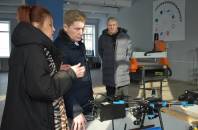 Губернатор Приморья оценил оснащение Индустриального колледжа в Арсеньеве
Очередной день работы Губернатора Приморского края Олега Кожемяко в муниципалитетах региона начался с посещения Приморского индустриального колледжа в Арсеньеве. Глава региона изучил новое оборудование, на котором готовят специалистов технических специальностей.
Губернатор Приморья оценил оснащение Индустриального колледжа в Арсеньеве
Очередной день работы Губернатора Приморского края Олега Кожемяко в муниципалитетах региона начался с посещения Приморского индустриального колледжа в Арсеньеве. Глава региона изучил новое оборудование, на котором готовят специалистов технических специальностей.
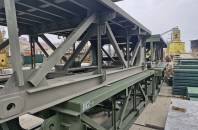 Комплекты быстровозводимых мостов начали поставлять в Приморье
Началась поставка средних автодорожных разборных мостов (САРМ) для проведения аварийно-восстановительных работ на дорогах Приморья. Всего на следующий год закуплено 11 комплектов. При необходимости комплекты САРМ будут использованы для оперативного восстановления проездов во время паводков.
Комплекты быстровозводимых мостов начали поставлять в Приморье
Началась поставка средних автодорожных разборных мостов (САРМ) для проведения аварийно-восстановительных работ на дорогах Приморья. Всего на следующий год закуплено 11 комплектов. При необходимости комплекты САРМ будут использованы для оперативного восстановления проездов во время паводков.
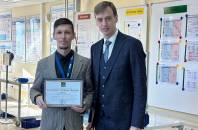 Почти 900 сотрудников предприятий Приморья уже владеют бережливыми технологиями благодаря нацпроекту "Производительность труда"
Итоги реализации национального проекта "Производительность труда" и планы на будущее озвучил министр экономического развития Приморья Андрей Блохин на награждении команды Регионального центра компетенций. За четыре года работы нацпроекта реализовано 78 проектов по внедрению бережливых технологий на предприятиях края.
Почти 900 сотрудников предприятий Приморья уже владеют бережливыми технологиями благодаря нацпроекту "Производительность труда"
Итоги реализации национального проекта "Производительность труда" и планы на будущее озвучил министр экономического развития Приморья Андрей Блохин на награждении команды Регионального центра компетенций. За четыре года работы нацпроекта реализовано 78 проектов по внедрению бережливых технологий на предприятиях края.

